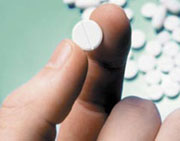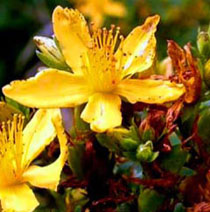|
by Shufeng ZHOU

 erbal products are becoming popular as alternative medicines worldwide. According to a 2004 update on the health risks of herbal remedies in Clinical Pharmacology and Therapeutics, about one third of adults in the developed countries and more than 60% Asians use herbal medicines for health promotion or treatment of various chronic diseases. The World Health Organization (WHO) in 1991 estimated that there were some 11,000 species of herbal plants for medicinal use and about 500 species of them are commonly used in complementary medicine. WHO defines herbal medicines as finished, labelled medicinal products that contain active ingredients from aerial or underground parts of plants, or other plant material, or combinations thereof, whether crude state or as other preparations." erbal products are becoming popular as alternative medicines worldwide. According to a 2004 update on the health risks of herbal remedies in Clinical Pharmacology and Therapeutics, about one third of adults in the developed countries and more than 60% Asians use herbal medicines for health promotion or treatment of various chronic diseases. The World Health Organization (WHO) in 1991 estimated that there were some 11,000 species of herbal plants for medicinal use and about 500 species of them are commonly used in complementary medicine. WHO defines herbal medicines as finished, labelled medicinal products that contain active ingredients from aerial or underground parts of plants, or other plant material, or combinations thereof, whether crude state or as other preparations."
Many patients take herbal products in combination with prescribed drugs without advising their doctors. The combined ingestion of herbs with drugs may raise the potential of herb drug interactions. Recent medical literature has recorded an increase in herb drug interactions although many studies are from case reports and limited clinical observations. However, herb drug interactions may be significantly under-reported and under-estimated. They are probably more frequent than drug–drug interactions because most patients (~70%) do not reveal their herbal use to their doctors and there is a lack of comprehensive surveillance system for monitoring the adverse effects of herbs and drug interactions in most countries.
In 2005, a National University of Singapore team comprising Zeping Hu, Sui Yung Chan, and the author published a review in the journal Drugs that many drugs interact with herbal medicines in humans. These drugs mainly include anti-coagulants (warfarin, aspirin, and phenprocoumon), sedatives and anti-depressants (midazolam, alprazolam, and amitriptyline), anti-HIV agents (indinavir, ritonavir, and saquinavir), oral contraceptives, cardiovascular drug (digoxin), immunosuppressants (cyclosporine and tacrolimus), and anti-cancer drugs (imatinib and irinotecan). Most of these drugs are ingested over a long period.
For most reported herb-drug interactions, the mechanisms are unknown. However, altered drug absorption, metabolism, and clearance by combined herbs play a critical role in these interactions. Many herbs can induce or inhibit liver and intestinal drug metabolising enzymes (e.g. cytochrome P450s), leading to altered drug concentration and clearance. Clinical studies have documented that St John’s wort reduced the plasma concentrations of cyclosporine, amitriptyline, digoxin, indinavir, nevirapine, oral contraceptives, theophylline, and simivastatin. Garlic supplement decreased the plasma concentration of the protease inhibitor saquinavir used in suppressing HIV, while licorice increases the plasma concentration of prednisolone, a synthetic steroid used in various compounds as an anti-in. ammatory, immunosuppressive, and anti-allergic drug. Induction or inhibition of cytochrome P450s is considered the major reason for these observed herb drug interactions.
On the other hand, some constituents from herbs may act on the same drug target molecules (e.g. receptors or enzymes), resulting in synergistic or antagonistic herb drug interactions. Synergistic or additive (enhanced) effects may lead to unfavourable toxicities and complicate the dosing regimen of long-term medications, while antagonistic interactions will result in decreased efficacy and therapeutic failure.
Warfarin (Coumadin) is one of the most frequently prescribed Reports of adverse effects in combining herbal medication and drugs bring up the need for safety monitoring and understanding of such treatment. There are some reports of interaction between warfarin and herbs such as St John's wort, Danshen, Dong Quai, ginseng, and ginkgo. These herbs such as Dong Quai contain coumarins, which may augment the effects of a coumarin-derived anti-coagulant. Furthermore, cases have been reported where the combination of St John' wort and selective serotonin re-uptake inhibitors (e.g. sertraline and nefazodone) caused severe symptoms such as confusion, agitation, hyperreflexia, shivering or tremor, diaphoresis, lack of coordination, fever, or coma. This may be due to that St John's wort inhibits uptake of monamines including serotonin, dopamine, and norepinephrine by neurons.
The clinical importance of herb-drug interactions depends on factors that are related to co-administered drugs (such as dose, dosing regimen, and administration route), herbs (species, dose, dosing regimen, and administration route), and patients (genetic variations, age, gender, and pathological conditions). Generally, a doubling or more in drug plasma concentration has the potential for heightened adverse effects. Less marked changes may still be clinically important for drugs with a steep concentration-response relationship or a narrow therapeutic index. In most cases, the extent of herb¨Cdrug interaction varies among individuals, depending on differences in drug metabolising enzymes, existing medical condition, age, and other factors.
 Potential herb-drug interactions are a major safety concern especially for drugs with narrow therapeutic indices (e.g. and digoxin), and may lead to severe adverse reactions that are sometimes life-threatening. For example, when St John's wort was combined with oral contraceptives, it caused intermenstrual bleeding and pregnancy. Combined St John’s wort also decreased blood concentrations of cyclosporine that was associated with transplant graft rejection. Ginseng induced mental disorder when used with phenelzine. Ginkgo raised blood pressure when combined with a thiazide diuretic used in controlling high blood pressure, and coma when combined with trazodone used as an anti-depressant. In addition, garlic produced low blood sugar level when taken with chlorpropamide, which is used to lower blood sugar in diabetes. Kava caused a semicomatose state when taken concurrently with alprazolam, a drug for treating anxiety. Potential herb-drug interactions are a major safety concern especially for drugs with narrow therapeutic indices (e.g. and digoxin), and may lead to severe adverse reactions that are sometimes life-threatening. For example, when St John's wort was combined with oral contraceptives, it caused intermenstrual bleeding and pregnancy. Combined St John’s wort also decreased blood concentrations of cyclosporine that was associated with transplant graft rejection. Ginseng induced mental disorder when used with phenelzine. Ginkgo raised blood pressure when combined with a thiazide diuretic used in controlling high blood pressure, and coma when combined with trazodone used as an anti-depressant. In addition, garlic produced low blood sugar level when taken with chlorpropamide, which is used to lower blood sugar in diabetes. Kava caused a semicomatose state when taken concurrently with alprazolam, a drug for treating anxiety.
Clinicians should adopt proper strategies to minimise toxic herb drug interactions. Early identification of drugs that interact with herbs and the mechanisms involved is important. Identification of drugs and herbs that interact with each other can be incorporated into the early stages of development of synthetic drugs and herbal medicines. If a drug has to be used in combination with a herb, the physician must ensure a safe drug combination regimen, dose adjustment, and discontinuation of therapy should toxic herb-drug interaction occur.
When herbs are combined with drugs with narrow therapeutic indices, the monitoring of plasma drug concentrations and observing of potential toxicities should be conducted. A doctor is likely to predict the risks for potential herb drug interactions when following proper pharmacological principles, as described in a simulation study of such predictions by the author and Wei Duan. Another approach for circumventing possible toxicity is proper design of drugs and/or modification of the herbal formulation (e.g. removal of specific constituents) to minimise the potential for undesired interaction.
Due to the potential adverse clinical effects of herb drug interactions, a strong need exists to describe these important interactions. This poses a major challenge because of the lack of comprehensive regulations regarding safety, efficacy, and manufacturing standards for herbal medicines. Some parties have proposed that herbs are appropriately labelled to alert consumers of possible interactions with other drugs, and to recommend a consultation with their general practitioners, pharmacists, and/or other medical carers. It is time to consider herbs not as alternative medicine based on tradition and experience, but as an integrated part of medical treatment, with proper regulations on safety (e.g. herb drug interactions), quality, and efficacy.
 Click here to download the full issue for USD 6.50 Click here to download the full issue for USD 6.50
|



 erbal products are becoming popular as alternative medicines worldwide. According to a 2004 update on the health risks of herbal remedies in Clinical Pharmacology and Therapeutics, about one third of adults in the developed countries and more than 60% Asians use herbal medicines for health promotion or treatment of various chronic diseases. The World Health Organization (WHO) in 1991 estimated that there were some 11,000 species of herbal plants for medicinal use and about 500 species of them are commonly used in complementary medicine. WHO defines herbal medicines as finished, labelled medicinal products that contain active ingredients from aerial or underground parts of plants, or other plant material, or combinations thereof, whether crude state or as other preparations."
erbal products are becoming popular as alternative medicines worldwide. According to a 2004 update on the health risks of herbal remedies in Clinical Pharmacology and Therapeutics, about one third of adults in the developed countries and more than 60% Asians use herbal medicines for health promotion or treatment of various chronic diseases. The World Health Organization (WHO) in 1991 estimated that there were some 11,000 species of herbal plants for medicinal use and about 500 species of them are commonly used in complementary medicine. WHO defines herbal medicines as finished, labelled medicinal products that contain active ingredients from aerial or underground parts of plants, or other plant material, or combinations thereof, whether crude state or as other preparations."
 Potential herb-drug interactions are a major safety concern especially for drugs with narrow therapeutic indices (e.g. and digoxin), and may lead to severe adverse reactions that are sometimes life-threatening. For example, when St John's wort was combined with oral contraceptives, it caused intermenstrual bleeding and pregnancy. Combined St John’s wort also decreased blood concentrations of cyclosporine that was associated with transplant graft rejection. Ginseng induced mental disorder when used with phenelzine. Ginkgo raised blood pressure when combined with a thiazide diuretic used in controlling high blood pressure, and coma when combined with trazodone used as an anti-depressant. In addition, garlic produced low blood sugar level when taken with chlorpropamide, which is used to lower blood sugar in diabetes. Kava caused a semicomatose state when taken concurrently with alprazolam, a drug for treating anxiety.
Potential herb-drug interactions are a major safety concern especially for drugs with narrow therapeutic indices (e.g. and digoxin), and may lead to severe adverse reactions that are sometimes life-threatening. For example, when St John's wort was combined with oral contraceptives, it caused intermenstrual bleeding and pregnancy. Combined St John’s wort also decreased blood concentrations of cyclosporine that was associated with transplant graft rejection. Ginseng induced mental disorder when used with phenelzine. Ginkgo raised blood pressure when combined with a thiazide diuretic used in controlling high blood pressure, and coma when combined with trazodone used as an anti-depressant. In addition, garlic produced low blood sugar level when taken with chlorpropamide, which is used to lower blood sugar in diabetes. Kava caused a semicomatose state when taken concurrently with alprazolam, a drug for treating anxiety.
 Click here to download the full issue for USD 6.50
Click here to download the full issue for USD 6.50